Abstract
On 8 September 2022, the American artist Frank Stella launched a series of twenty-two digital art works minted as Non-Fungible Tokens (NFTs) in collaboration with Arsnl, the in-house platform by the Artist Rights Society (ARS). Titled Geometries, each “package,” included the NFT that would affirm ownership and the corresponding geometric model designed by Stella in JPG (image), MP4 (video), SLS (3D printing), GLB (virtual reality and model manipulation), and USDZ (augmented reality). This range of digital formats alludes to two of Stella’s innovations in this space: the license to remix and manipulate his models, and the ability to 3D print Geometries at any color, scale, and material. Taking Stella’s foray into the NFT-space as a starting point, my article focuses on an emergent trend by artists engaging with Web3: the effort to bridge the physical and the digital by giving tangible form to NFT artworks and what this suggests for the future of digital materiality. The paper at its core seeks to examine the relationship between the physical referents to NFTs at the very moment when new media returns to historical forms.
Keywords:
NFTs; Prints; Sculpture; Contemporary Art; Blockchain; Cryptocurrency; American Art; Printmaking; Digital Art; Frank Stella 1. Introduction
“…the scale on which the structure is operational in contemporary technoscience and artistic experimentation is no longer a human one”.Jean François Lyotard (1985)1
“No matter how digitized the work gets in the process, it always ends up a physical reality”.Frank Stella (2022)2
In 1985, the French philosopher Jean-François Lyotard and Thierry Chaput organized the revolutionary exhibition, Les Immatériaux, on the fifth floor of the Centre Pompidou in Paris. Since heralded as a paradigm-shifting show, the works on display spanned across disciplines—from biosciences to plastic arts—and ranged from Dan Flavin’s neon works to synthetic skin to video games. At its core, Les Immatériaux sought to negotiate how the materialization of new media resulting from encroaching globalization simultaneously dematerialized the notion of the subject. For Lyotard and Chaput, the intangible scale of technological progress was seen to disrupt the Cartesian model of the visitor experience of objects. Instead, they asserted, “new technology pursues and perhaps accomplishes the modern project of becoming master and possessor. But in so doing it forces this project to reflect on itself; it disturbs and destabilizes it” (Lyotard and Blistène 1985, pp. 32–39; Hudek 2009).3
Les Immatériaux’s collective anxiety over the porosity of material experience remains prescient today, particularly in the widespread adoption of blockchain technology in cultural production. This essay considers a project by the venerable American artist Frank Stella (b. 1936), who launched a series of twenty-two digital artworks minted as Non-Fungible Tokens (NFTs) in collaboration with the Artist Rights Society (ARS) on 8 September 2022. Titled Geometries (Figure 1), the project combined Stella’s sustained attention to copyright infringement and intellectual property protection for artists with his interest in expanding the material limits of reproduction. In fact, each NFT “package” included the token itself, the corresponding geometric model designed by Stella in JPG (image), MP4 (video), SLS (3D printing, Figure 2), GLB (virtual reality and model manipulation), and USDZ (augmented reality), and the “smart contract” (or blockchain-based code) governing how ownership can be transferred.4 This range of digital formats alludes to two of Stella’s innovations in this space: the license to remix and manipulate his models, and the ability to 3D print Geometries at any color, scale, and material (Figure 3). Taking Stella’s foray into the NFT space as a starting point, my article focuses on an emergent trend by artists engaging with Web3: the conceptual and material efforts to bridge the physical and the digital.
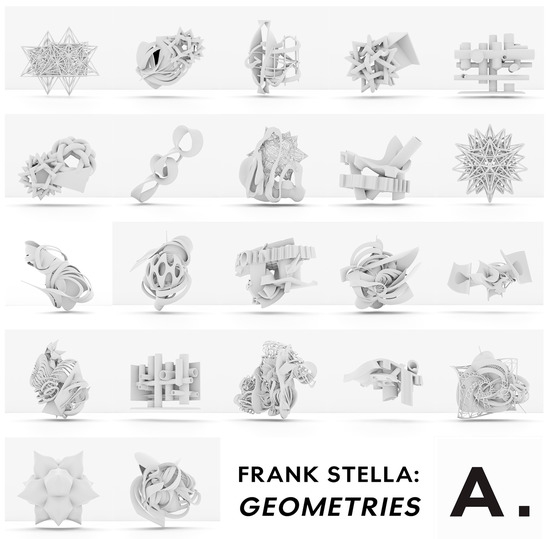
Figure 1.
Frank Stella, Geometries, 2022. Photo courtesy of ARSNL. © 2022 Frank Stella.
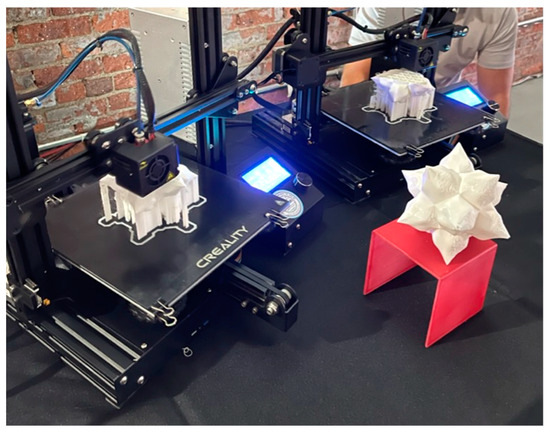
Figure 2.
Creality’s 3D printing of Frank Stella’s Geometries. Photo by the author, 8 September 2022.
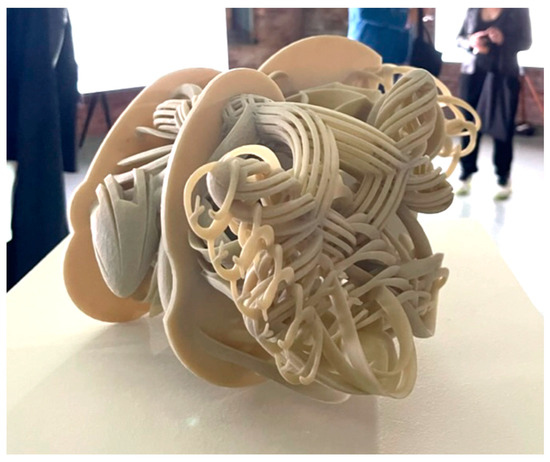
Figure 3.
A 3D printed model of Frank Stella’s Geometry XVIII. Photo by the author, 8 September 2022.
Stella’s works are a particularly rich case study in the dilemma of a “phygital” work (a portmanteau that combines a physical object and digital manifestation.5 The term was in use by the mid-2000s in relation to retail experiences and was widely adopted in 2020 with regards to Web3-driven curatorial practices.6 My article specifically focuses on four concurrent themes that emerge from Stella’s project. I first begin by tracing a brief history of the invention of NFTs and how Stella’s interest in the technology is intrinsic to and preceded by the very intention behind its creation. I then outline Stella’s project in relation to his own artistic production, particularly the Geometries’s formal relationship to printmaking, and how Stella’s approach diverges from contemporary works that also engage with the value of phygital works, such as Damien Hirst’s The Currency (2021–2022). Thirdly, I consider the concept of digital materiality in terms of how NFTs have been publicly exhibited. Here, I consider works by artists such as Jennifer and Kevin McCoy and LoVid as they leveraged aspects of blockchain technology to recenter agency and reorder material values with regards to conditions of their institutional displays. Finally, I argue that debates central to the NFT space find historic and already articulated parallels in institutional documentation of performance and time-based works. Ultimately, at its core, I argue that Stella’s project demonstrates the porous boundaries of the materiality of new media, and unpacking NFTs’ recourse to historical tangible forms outlines conceptual and theoretical debates crucial to future institutional exhibition, installation, and presentation of fine art NFTs.
2. “To Create Indelible Provenance”: A Background on NFTs
In a conversation in September 2022 with the digital artist Andres Reisinger, Frank Stella defined what he saw as three advantages of NFTs, stating, “they are a way to address ownership and reproducibility of digital art. They can also have built-in resale rights”.7 From the onset, NFTs were created with these very themes as their central mandate. At its very base, a “Non-Fungible Token”, is a type of publishing technique that creates (“mints”) unique, limited, or open editions of tradable digital assets. The art market journalist Tim Schneider has succinctly unpacked the importance of the two-part term writing, “The ‘non-fungible’ aspect comes from the fact that each NFT has a value independent of all others, including different editions of the same work, kind of like fine-art photographs or prints. ‘Token,’ meanwhile, is a term of art for a unique alphanumeric code recorded on the blockchain. Like an inventory number or tracking code, the token locates the actual asset within a larger system”.8 The resulting product is a secure combination of blockchain technology and digital media files that permanently encodes authenticity, provenance, and sales history through a smart contract on a blockchain. A smart contract is a program that runs on a specific blockchain, the latter is a largescale database composed of a cooperating network of computers.9 Having this data “on-chain” not only endows each version of the work with its unique value but also initiates the possibility of guaranteeing artist rights in an unprecedented way.
The inaugural marriage between a visual work with the permanence of the blockchain occurred in 2014 at a yearly hackathon organized by Rhizome, titled “Seven on Seven” (7 × 7), which paired artists with technologists for a day.10 There, the artist Kevin McCoy (one half of the artist duo Jennifer and Kevin McCoy) was paired with the technologist and writer Anil Dash. Driven by McCoy’s desire to “use blockchain technology to create indelible provenance and ownership of digital images”, the duo minted the first NFT, Quantum (Figure 4, 2014–2021) which essentially was a combination of two things: a digital file and a registration on a blockchain (Jennifer and Kevin McCoy 2014). The digital file was a visually generative work by McCoy that featured a psychedelic mirage of pulsating concentric shapes inspired by cycles of life and movement. The registration of Quantum on a blockchain (specifically, the Namecoin blockchain) was a determined rejoinder to the problems inherent in the digital dissemination of works. Instead of allowing works to be shared without proper attribution or remuneration to the maker, NFTs permanently connected a digital file to the maker by creating a scarcity framework around an otherwise infinitely replicable digital asset, and in so doing, impose the same kind of conceptual and market dynamics on digital works that preexist for physical works.
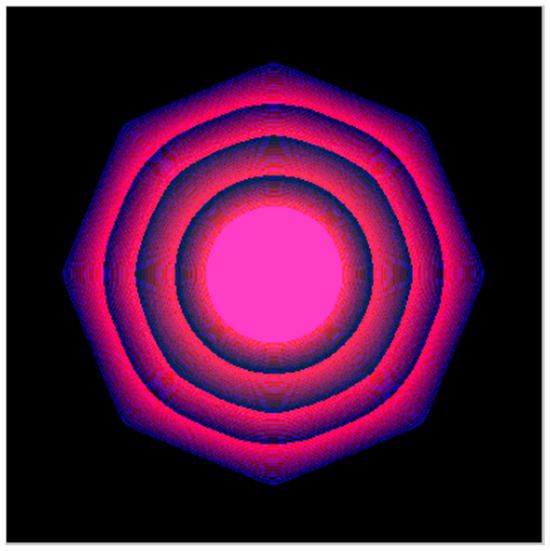
Figure 4.
Kevin McCoy, Quantum, 2014. NFT (Screenshot of a GIF). Photo courtesy of Postmasters Gallery and the artist.
While NFTs were thus invented in 2014, market and institutional attention to this new technology paralleled the art world’s interest in cryptocurrency, reaching highs from 2020 to 2022 driven by speculative investment. The former is best exemplified by the founding of the Sotheby’s “Metaverse” department in September 2021, and the latter by the active minting of works from their permanent collections by museums such as the British Museum, the Galleria degli Uffizi, and the Hermitage Museum.11 These different classes of entities collecting and trading NFTs allude to an extended gap in artists’ rights that should have been guaranteed by the smart contracts: at Sotheby’s, secondary market sales of traditional artworks do not benefit artists directly, and at museums, the sales wholly benefit the institution as works are often minted after long-deceased artists without estates to manage their interests in the present day. In this gap, the Artist Rights Society (founded in 1987) launched its own in-house platform on August 2022.12 This new platform, Arsnl, defined its mission as bridging “the fine art world and digital art space through collaboration and intellectual property protection”.13 For them, launching their digital platform with a series of works by Frank Stella combined two aspects: Stella’s sculptural practice which in themselves formally embraced digital tools, and the artist’s long-time campaign to codify resale royalties for artists. Indeed, there is a ten percent resale royalty embedded in the smart contract of each edition of Geometries.14 However, analysis of Geometries to date has treated the series as an unindividuated whole. Through close consideration of the forms selected for the series, I assert that they are deeply indebted to and formally oriented toward reproductive technologies.
3. The Geometry of Frank Stella’s Geometries
Geometries (Figure 1) is composed of twenty-two asymmetric interwoven cylinders and polyhedrons whose open trusses are sometimes perforated by rogue vectors. Each of the twenty-two forms were issued in editions of one hundred. One-third of them highlight the star motif that has been central to Stella’s work since the 1960s and is as much a part of his visual signature as his study of smoke rings.15 As previously noted, the structures are natural extensions of Stella’s artistic practice. Iconographically, they fall within the lineage of Stella’s sculptures and paintings made with CAD/CAM software, such as the following series of works: Italian Folktales, (1988–1989), Imaginary Places (1994–1999), Bali (2002–2009), and Scarlatti K (Figure 5; 2006-present).16 These polychrome calligraphic reliefs defy categorization as 2D or 3D objects to instead revel in what Frank Stella called “frozen gestures”, that in turn activate a visual and a virtual mode of seeing.17 It is thus impossible to determine whether Stella’s interest in these forms or the technology to realize them came first; Jason Bailey noted in his essay for the launch of Geometries that it was serendipitous that “Stella’s march toward increasingly complex geometries coincided perfectly with rapid advances in computer-aided drafting (CAD), digital fabrication, and 3D printing”.18 However, Geometries and their extended visual and structural concerns are extensions of his earlier work in theorizing and engineering the relationship between space and surface.
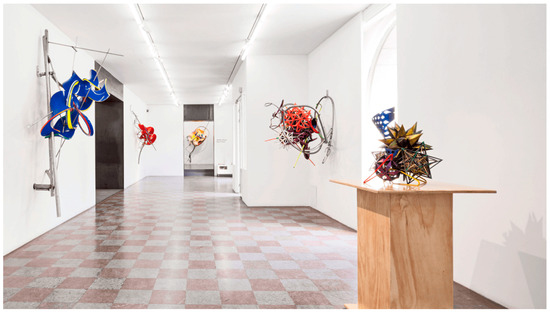
Figure 5.
Installation shot of “WG. 62: Frank Stella, Recent Work”, 4 June–5 July 2013, Wetterling Gallery, Stockholm, Sweden. Photo: Jean-Baptiste Béranger. Courtesy of Wetterling Gallery, Stockholm. © 2023 Frank Stella.
By virtue of their multiple digital formats, Geometries is simultaneously in motion (MP4) and in flattened 2D space (as a JPG). The fluidity of the forms across linear and dimensional spaces is primarily rooted in Stella’s own approach to “pictorial space”, which he historically situated “in-between” 2D and 3D.19 This fluctuating space is the culmination of a sort to Stella’s inexorable drive toward creating “a sense of motion and action within a static medium” (Stella and Clearwater 2000, p. 86). This attention to space may even be conceptually traced back to Stella’s Irregular Polygons (1965–1966), a series of eleven individual compositions with four color variants (totaling forty-four paintings) featuring variations of interlocking and abutting asymmetric shapes. Considered a radical shift from his previous striped paintings, Irregular Polygons were innovative forms that addressed space and vision, even occupying a central role in Michael Fried’s influential essay, Shape as Form (1966).20 For Stella, interrogations of space remained central to his work thereafter, best exemplified by his “Working Space”, a series of six Charles Eliot Norton Lectures delivered at Harvard University from 1983–1984 where he expounded on the relationship between the state of abstraction vis-à-vis venerable Old Masters such as Caravaggio, Michelangelo, Titian, Peter Paul Rubens, Diego Velazquez, and Leonardo da Vinci. There, Stella asserted that “the aim of art is to create space—space that is not compromised by decoration or illustration, space in which the subjects of painting can live”, a view that seems ever pertinent in his exploration of digital and virtual space.21 For Stella, paintings and sculptures oscillated in the same multidimensional space, a perspective that echoed the contemporaneous attention to the fluidity of the sculptural medium itself. Rosalind Krauss has notably stated in her influential essay, “Sculpture in the Expanded Field”, that “for, within the situation of postmodernism, practice is not defined in relation to a given medium-sculpture-but rather in relation to the logical operations on a set of cultural terms”, arguing for an “organization of work that is not dictated by the conditions of a particular medium” (Krauss 1979, pp. 42–43). In fact, with regards to his Scarlatti K-series—to which Geometries have been most extensively compared—Stella saw his wall-mounted relief configurations as “multidirectional paintings”, as they “function in a pictorial way”.22
Beyond his conceptualization of pictorial space, the specific geometries of Geometries stage a meta-argument into new spatial materiality as they are Euclidean solids staged in non-Euclidean space. On the one hand, Stella has always demonstrated an interest in new materials throughout his career by incorporating fiberglass, carbon fiber, and plastics made through prototyping technology and synthetic resins into his works.23 On the other hand, his formal inspirations have a historic basis in early modern explorations of perspectival geometry and their (in)ability to be translated into different materials. We might compare Stella’s colliding and exploding forms to sixteenth-century goldsmith Wenzel Jamnitzer’s exploration of Platonic solids (Figure 6) that were then subsequently realized in new materials such as lathe-turned ivory or innovations in metalworking. Stella has additionally noted that his works are not only about “computing the faces of polygons” but also speak to the symbiotic relationship between material and form, asserting in 2012 that his adoption of improved plastic material has lent themselves to the creation of new complicated shapes for the Scarlatti K-series (Stella et al. 2017, p. 16; 2012, p. 24). The emphasis on Platonic solids central to Geometries preemptively positions the forms toward reproductions either as 3D printed forms in physical space or as digitally encoded materials suspended in virtual space.
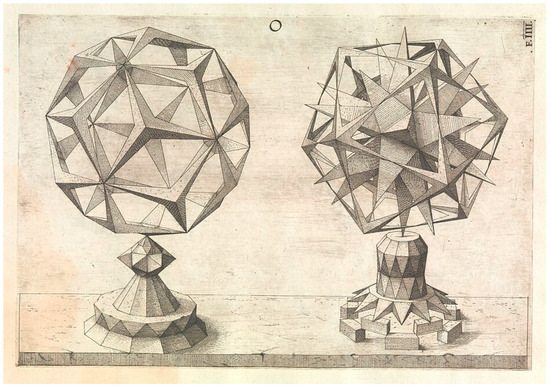
Figure 6.
Jost Amman after Wenzel Jamnitzer, Perspectiva Corporum Regularium, Plate O, F.IIII, 1568. Etching on Paper. 35.0 × 25.5 × 1.0 cm. Inv. no. 24.45.1. Harris Brisbane Dick Fund, 1924. The Metropolitan Museum of Art, NY. Image in the Public Domain.
This link between form and material is further compounded by Stella’s resuscitation of earlier shapes in Geometries. Some were previously licensed for merchandising. For example, Geometry XII (third row down and second column from the left in Figure 1) reprises the same model as a gold ring Stella made in 2008 with the Dutch designer Ernest Mourmans (Figure 7), the first “wearable art” the artist has produced. Additionally, his open-weave stars are similar, if not identical, to the holiday ornaments Stella designed for the Whitney Museum of American Art’s shop in 2014. Practically, these tried-and-tested models would have been ideal additions to Geometries, given that they had been once stably realized in the corporeal form. The resuscitation of these compositions into digital files inherently orients Geometries as a series intended for reproduction by dually co-opting Stella’s formal exploration of new materials and to a certain extent, referencing early modern artistic experimentations in Platonic solids.
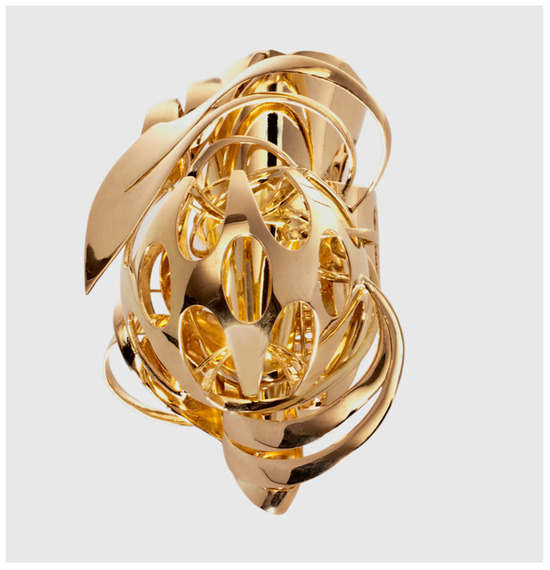
Figure 7.
Frank Stella, Ring, 2008. 19 kt yellow gold ring, 4.4 × 8.9 × 5.1 cm. Edition of 10. Signed and numbered. Photo: Deniz Guzel, Courtesy of Elisabetta Cipriani.
4. Stella[r] Prints
The individual forms of Geometries are tied to Stella’s interest in reproduction, particularly printmaking. To a degree, the open-endedness of the shapes is preceded by Stella’s earlier works, as he has always been interested in expanding the framework of formats through repetition and seriality.24 For Stella, however, printmaking has a long material history. He famously claimed to have “absorbed printing—a printmaking way of thinking—into the pattern of [his] normal thought process” (Stella and Clearwater 2000, pp. 84–85). Given this, the 3D printed models after Stella and his tokenization of the series on the blockchain may be seen as types of prints. In fact, many adopters of blockchain technology have made similar comparisons: Hannes Koch (one of the co-founders of interdisciplinary art studio Random International) has discussed the merger between NFTs and immersive installations as akin to publishing a print. For their installation Living Room (2022), Random International converted a visitor’s spatial journey inside the work into digital line drawings that could then be minted as NFTs, with Koch saying that for artists “whose work is code and cameras and displays, this is the appropriate format to add to the canon of lithographs and editioned prints”.25 This comparison to printmaking is particularly persuasive in the context of Stella’s œuvre as printmaking was strongly linked to his exploration of technology and new media (Stella and Clearwater 2000, pp. 81–91; Stella et al. 2017, p. 22).
Here, I return to the star motif in Geometries, which remains recognizable in seven of the twenty-two forms or elsewhere deconstructed into vectors. From the onset, the star motif served as Stella’s geometric self-portrait, as recorded in a drawing from 1960–1961 in which he translated his peers into abstracted shapes.26 As a shape, the star was central to Stella’s interest in printmaking as it formed the basis of the first series of prints he ever published: a series of lithographs made in collaboration with the master printer Kenneth Tyler for Gemini G.E.L in 1967 (Stella et al. 2020, pp. 16–17). The Stars of Persia series was later described by Stella in 1995 as the “perfect example of an artist’s frustrating introduction to a new medium”, as he lamented the inability of the paper to match the complex spatial intermediality of his paintings and reliefs (Stella and Clearwater 2000, p. 87). In the same lecture, Stella even speculated on the future possibility of a “built” print, imagining “a more malleable type of paper that could stretch itself in more than one direction, a paper with the properties of spandex”, while at the same time stressing that he sought to explore a type of printmaking that would not exist after a painting but rather prints that “could be made concurrently, simultaneously” (Stella and Clearwater 2000, pp. 82, 89). The digital capabilities of Stella’s NFT project thus allow his models to exist simultaneously across media. As such, the resonance of the star shapes in Geometries underscores Stella’s long-time interest in the possibilities of reproduction and positions his approach to NFTs as a type of printmaking.
This concept raises a vital question: are the printed models akin to editioned prints whereby the value of the work equivocates between the printing matrix and their imprints? Legally, Arsnl and Stella are quick to identify a major difference between this cross-media afterlife of Stella’s Geometries. According to the official “Collector’s Rights Agreement”, the owner of Geometries is given four main rights: to create derivatives using the geometry as source material; to 3D-print the form at any scale, material, or color; to use and display the NFT and the models in physical and virtual spaces (i.e., the metaverse); and finally, to resell the NFT on any platform or marketplace that recognizes its digitally embedded resale royalty provision in the smart contract. In the case of the last, the previous owner is allowed to retain any models or derivatives they created during the time they owned the work. Yet, one of the more ambiguous aspects of Geometries is that the fine print states that the models (such as Figure 2 and Figure 3) are not considered to be an artwork by Frank Stella, and authorized only for “personal, non-commercial use and may not be gifted, sold, or transferred or otherwise used or exploited” (Arsnl and Open Sea 2022). How might we reconcile these seemingly divergent approaches to agency, phygital materiality, and their corresponding artistic values? In this section, then, I will address this dilemma by turning to other works that overtly test the digital and physical in tokenized works. A productive comparison may be made between Stella’s devaluing of a printed model of Geometries and Damien Hirst’s The Currency (2021–2022), an infamous contemporaneous project that staged a diametrically opposed argument to Stella’s. This debut NFT project by Hirst questioned the materiality of value itself. In 2021, Hirst minted digital reproductions of 10,000 unique works on paper he had hand-painted in 2016, essentially giving each NFT a physical counterpart (HENI and Damien Hirst 2021–2022). Taking the conceit a step further, Hirst mandated that the owner of each NFT had a grace period of a year to sell and exchange the token ad infinitum, but at the end of the year, the owner at the time would have to choose between either the tokenized digital work or the physical work. For those that opted for the digital, the corresponding work-on-paper was to be destroyed, a process that Hirst claimed was “bringing the works to life”, a curious inversion of Theodor Adorno’s argument on the synchronicity of museum as a mausoleum (Adorno 1983). Indeed, the unclaimed physical works were burned by the artist himself on 27 July 2022 (Figure 8) (Rea 2022; Morton 2022).
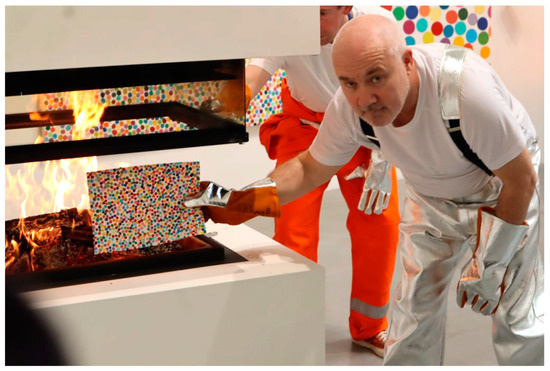
Figure 8.
Damien Hirst, The artist at Newport Street Gallery for the grand finale of The Currency. Photo: Courtesy of Naomi Rea, 27 July 2022, Published in Artnet News, 12 October 2022.
The title of Hirst’s work, The Currency, not only addresses the outsized attention to the market in the NFT space but also alludes to longstanding concerns regarding digital materiality, a term that encapsulates inquiries into how digital processes, forms, and intentionalities intersected with their material counterparts (See also Pink et al. 2016; Geismar and Knox 2021). Recent approaches to the concept have advocated not for a dichotomy between the material and the digital, but for an acknowledgment of multiple levels of concurrent operations. For instance, Heather Horst and Daniel Miller noted in 2012 that digital materiality is comprised of attention to “digital infrastructure and technology…of digital content…and digital context” (Horst and Miller 2012, p. 25). In terms of traditional plastic arts, companies such as Factum Foundation have sponsored academic publications on how their projects in the cultural heritage preservations sector intersect with historical models for early modern arts and architecture (Lowe 2020). Hirst’s combination of hand-made paintings on paper and NFTs can be considered alongside an assertion Jacques Derrida made in the exhibition catalogue of Les Immatériaux. Derrida emphasized the exchange function inherent in the term, “material” asserting that it “resonates like a currency, a currency of exchange with the history of its concept, paying homage to the ‘tradition of modernity.’”27 While new materiality as a type of currency is at the core of Hirst’s experimentation, in practice, 51.5 percent of the token holders (5149) opted for the physical referent over the digital, a number that does not include Hirst’s personal purchase of 1000 of his own NFTs to keep them in their digital form (Rea 2022). The end result of Hirst’s experiment was that when faced with a direct one-to-one value proposition, the physical artwork was preferred over the digital. Conversely, Stella’s Geometries does not equate the physical form (i.e., the model) with the digital file, in turn allowing for the work to remain digital and negate any Hirst-like debates over value. Instead, Stella’s project fuses the perceived “authority”, of the work with the conditions enumerated in the blockchain. In other words, instead of dematerializing artistic authorship through intangible multimedia, it rematerializes a type of digital materiality inherent to the character of the blockchain.
5. Private Star/Public Star
This tenuous relationship between the visual, physical, and structural character between the conditions of an NFT, its digital work, and its physical counterpart is made even more tenuous once NFTs enter institutions, and thus become subject to circumstances of display not necessarily compatible with the work’s internal demands. In this section, I consider Stella’s Geometries alongside two NFT projects in the collection of the Whitney Museum of American Art: NFTs by LoVid (an artist duo composed of Tali Hinkis and Kyle Lapidus), and by Jennifer and Kevin McCoy. Their projects offer differing approaches to the integration of NFT into their practice that in turn illuminate the future potential of the medium.
Stella’s project as discussed above, does not only eschew physical materiality by denying their reproductions as authored artworks, but also seemingly denies a physical form to the digital files by refusing to specify which equipment should be adopted for in-gallery presentation. Compare this to the approach of LoVid. Two versions of their eighteen video series Hugs on Tape (Beals, 2021 and David/Tanya, 2021) were some of the earliest NFTs acquired by the Whitney.28 The works themselves (Figure 9) feature two layers of video: a loop of an analog video of a spontaneous hug that is then digitally overlaid with colorful patchwork designs. According to Hinkis, these fabric-like patterns were originally generated with analog synthesizers, circling back to what Sadie Plant referred to as the inevitable alignment between fibers and filaments, as cables essential to the technological operation of digital networks were seen as akin to the production of textiles (Plant 1997). Just as Stella’s Platonic forms were embroiled in the history of material reproductions, the visual patterns in LoVid’s works are generated from the materiality inherent in the technological media itself.
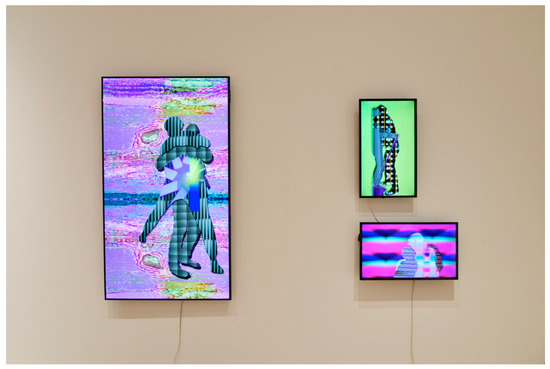
Figure 9.
LoVid, Installation view of “Hold On” (19 March–23 April 2022). Courtesy of Postmasters Gallery and the artists.
Hugs on Tape remains a particularly interesting case in terms of the musealization of NFTs. In a conversation on June 2023, Hinkis noted the physicality of digital art—actualized through her specification that the work at the Whitney be presented on a screen—by describing Hugs on Tape as a type of painting that operates at the “scale of the body”.29 LoVid emphasized the apparatus of the display, with Hinkis asserting that the work was “not so much about the mechanism of the NFT” but rather a reaction to the “recognition of the historical moment”, meaning a response to the speed and indiscriminate influx of works at the height of the NFT market boom in 2021 (Ibid). True to form, earlier showing of the work at the Postmasters Gallery in 2022 (Figure 9) displayed their work on screens of varying sizes, privileging physical format of the files instead of, for example, having a centralized device that would enable visitors to click through multiple files. Madga Sawon, the co-founder of Postmasters (who has worked with both LoVid and Jennifer and Kevin McCoy) outlined three important factors in displaying NFTs: the ratio of the NFT, preference by the artists, and what is possible given the resources.30 Sawon additionally outlined that there exists a “whole hardware industry producing NFT screens”, that will “soon be obsolete like much of technological march”, alluding to the concerted attention toward devices that give physical form to the digital (Ibid). As such, in the case of LoVid’s work, an institutional recognition of the work as an NFT recorded on the blockchain is essential not to the work’s inherent visual, physical, and material operation but instead to its cultural context.
Conversely, consider the McCoys’ project Public Key/Private Key (2019) that recentered the issue of value in the contractual potential of the NFT as a medium in relation to institutional presence. The work infused capabilities afforded by the blockchain into the Situationist strategy of detournement: a reworking of public symbols and images with subversive social meanings and historical memories. This project was launched online on 5 March 2019, at the Whitney Museum of American Art’s official website. The work was comprised of two components: first, a unique 16 mm film shot in Lake Oscawana in New York and housed in a metal canister, and second, fifty of what were then called “blockchain certificates” (NFTs before the term became commonplace) awarded to fifty individuals deemed to have submitted the most compelling essays in response to an open call asking why they should become one of the donors of the work (Jennifer and Kevin McCoy 2019; See also Jennifer and Kevin McCoy 2018). The work is a contemporary update to institutional critique that sought to deconstruct institutional authority notably exemplified by works such as Hans Haacke’s MoMA Poll (1970) and Krzysztof Wodiczko’s Hirshhorn Museum, Washington D.C. (1988) that overtly intervened into the historical dialectics of conceptual art. Just as these works sought to expose the hidden underpinnings of institutional space and governing structures, the McCoys’ work sought to address the role of donors vis-à-vis ownership of art in museums.
The work confronts the false neutrality of works within museum spaces and interrogates the power dynamics between art institutions and their donors by altering the private and public aspects of ownership. The title of the McCoys’ work is a play on the conception of public-key cryptography, which generates separate public and private “keys” (essentially, passwords) offering different levels of access to encrypted data that can then be communicated confidentially, such as in the use of digital signatures.31 It is for this reason that public-key cryptography is also sometimes called asymmetric cryptography. Similarly, the work operated on two levels. On the public side, the fifty selected winners’ names were all recorded “on-chain”, as a list of donors was to be included in every future display of the 16 mm film. (The film itself also includes a depiction of a blockchain key that, upon the film’s showing at the Whitney, would earn the first viewer to transmit it to the artists a fifty-first donor NFT.) On the private side, each of the fifty original participants were also permitted to transfer, gift, or sell their blockchain certificate at their discretion. As the certified donors of the work changed through swaps and sales of the NFTs, however, the public key—that is the ledger at the Whitney—stopped being updated six months after the project’s initiation, locking the public donor list in place regardless of its members’ subsequent trading activity.32 In other words, while the actual composition of the donor cohort might change ad infinitum after the artist-imposed deadline, new names would not be memorialized in the museum record. This wrinkle profoundly questions the worth of the NFT transactions, resulting in a work that Tim Schneider has argued “distill[s] its value proposition to the visible credit for its donation” (Schneider 2019). Here, the physical 16 mm work has no intrinsic value—its function hinges on the dual recordkeeping uniquely enabled through the work as an NFT.
Similarly, Stella’s work at its base also offers a reconsideration of the potential of blockchain as a medium by elevating the ability of the technology over the plastic arts. While Geometries seemingly decentralizes its materiality through co-creation with, and participation by, its owners, in actuality the series centralizes authority with Stella by negating the value of any reproduction and subjugating its operational and financial value to the blockchain conditions, in turn safeguarding the artist’s rights. The copyright law professor, legal historian, and artist Brian Frye distinguished between NFT works “for which the token is the medium” and “NFTs consist[ing] of a URL. In other words, they represent ownership of a work of art” (Frye 2023). By focusing on how and where material values manifest in NFT works, whether it be the visual form, the apparatus of presentation, or its internal conditions of circulation, the works of Stella and his peers in this space demonstrates the collision that occurs between the digital token and its will to physicality.
6. Documenting the Non-Fungible
The unifying force between the works explored is their ambivalent relationship to their physical manifestations. In my view, this attention to materializing the intangible operations of NFTs can be productively framed in earlier cases where non-plastic arts were faced with the very plastic demands of a collection, such as the case of performance art. Time-based performances are by nature ephemeral events that, in the view of some artists and conservators, can never be repeated. For example, Peggy Phelan has stated that “performance’s only life is in the present. Performance cannot be saved, recorded, documented, or otherwise participate in the representations of representations: once it does so, it becomes something other than performance” (Phelan 2006, pp. 146–48). At the same time, the primacy of exhibition remains central with Peter Osborne asserting in 2013 that “the art market may still be trading in individual works, but it is the exhibition that is the unit of artistic significance, and the object of constructive intent” (Osborne 2013, pp. 167–68).33 Given this tension between NFTs and the apparatus of its display, I offer a thought experiment: might the interwoven hierarchies of material values of NFT projects be institutionally staged as a type of a performance?
Often, institutional display of performance art relies on satellite ephemera to represent the original work. One of the more recent instances I witnessed of this long-standing paradigm was at a monographic exhibition on the Chilean dancer and performance artist Sylvia Palacios Whitman (active in New York in the 1970s and 80s) staged at the Americas Society, NY (7 June–22 July 2023) The exhibition represented Palacios Whitman’s performance pieces through a wide variety of media (Figure 10) including audio and video recordings, photographs, props, artist’s statements, and drawings. It should be noted that not all performances can reliably turn to documentation; for example, Tino Sehgal famously does not allow records of any kind to be made of his performances. Even when video and photographic documentation is allowed, it is often not considered to have an indexical relationship to the work. At times, it becomes a new work altogether. For instance, Babette Mangolte, a prolific photographer of the downtown performance scene whose recordings of Palacios Whitman are featured in the Americas Society exhibition, has argued that visual documentation of performance art can “mislead” its audience, stating, that one has to, at times, “fight the documentation in order to rethink the performance”.34 Despite Mangolte’s reluctance to have recordings replace it, documentation, i.e., physical reproduction of the event, is essential to the future analysis and historicization of a performance piece—similar to the inclination toward physical counterparts of many NFT works, including Geometries.
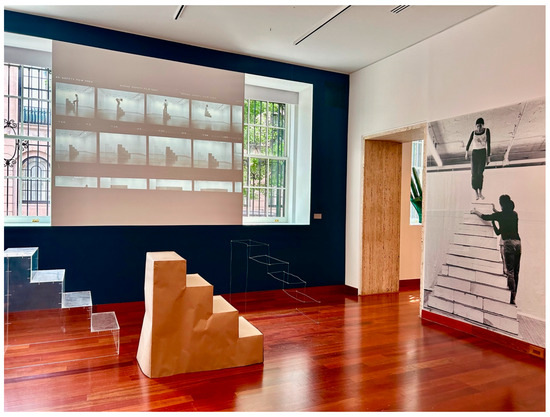
Figure 10.
Installation view, “Sylvia Palacios Whitman: To Draw a Line with the Body”, (7 June–22 July 2023), America Society, New York, NY. Photo by the author.
To return to Stella, he noted in 2022 with respect to Geometries that “no matter how digitized [Geometries] gets in the process, it always ends up a physical reality”.35 In fact, the “Collector’s Rights Agreement” is careful to enumerate that reproductions can be shown in non-profit spaces, including museums.
This emphasis on the “physical reality” despite its lack of resale value ultimately gestures at the dual level of ideological demands levied at a new media artwork: a dual desire for concrete physicality by the institution showing it and the public consuming it. This expectation imposed on reproductions of Geometries versus the actual condition of the work can thus be compared to what Philip Auslander has outlined in his study of the performativity of performance art documentation. Auslander asserts, “the crucial relationship is not the one between the document and the performance but the one between the document and its audience. Perhaps the authenticity of the performance document resides in its relationship to its beholder rather than to an ostensibly originary event” (Auslander 2006, p. 9).
Just as the various modes of physically archiving performances presage their eventual institutional displays, analyzing the materiality of NFTs in each iteration of their multimedia formats is essentially an exercise in viewership and how it aligns with the decisive transparency granted through the blockchain. Unpacking new media’s return to historical forms demonstrates how it is only through historical forms that the new media can assert its material innovations.
7. Conclusions
This article has sought to use Frank Stella’s Geometries as a prism through which to view the complex relationship between the visual, physical, and structural aspects of NFTs, with an eye toward the following questions: What precipitated Stella’s turn toward this new medium? How do the works’ formal elements relate to their digital processes? And how does this series navigate contemporary institutional demands? To that mandate, I first contextualized the development of NFTs alongside Stella’s long-standing interest in artist’s resale royalties. Having established Geometries as a conceptual extension of his overall artistic practice, I next explored how individual geometries in the series connect to historical, artistic, and material aspects of Stella’s engagement with reproducible media, most notably printmaking. Third, I turned to contemporary digital artists’ unease with “phygital” art in our contemporary moment. This anxiety unfolds at the levels of both value and presentation. With regards to the former, a productive foil to Stella’s reproducible geometries is Hirst’s The Currency, which inherently argued for a one-to-one relationship between physical and digital. With respect to the exhibition, I compared Geometries to NFT projects by LoVid as well as Jennifer and Kevin McCoy, both of which reside in the collection of the Whitney Museum of American Art. These projects highlight the evolving dialectic of NFTs in institutional contexts by offering distinct examples of how artists negotiated the complex and ambivalent relationship between the digital and the material, the virtual and the spatial. Finally, I offered a thought experiment comparing the multiple layers of Stella’s Geometries and its corresponding hierarchies of value to the fraught dynamics of exhibiting performance art. Ultimately, the material innovations of new media can best be understood when examined in relation to historical forms, emphasizing the interplay between their creative operations and their material orientation toward their presumed audiences.
Stella’s work exemplifies a thoughtful intersection between art and digital technology. While the multiple formats of the Geometries appear to dematerialize artistic authorship, Stella’s project rematerializes digital materiality through the nature of the blockchain. At a broader level, this article hopes to continue the conversation concerning the conceptual and material stakes in this nascent wave of artistic and institutional inquiry, with the promises and shortcomings of NFTs manifesting through their conditions, their mediation of the digital and the physical, and the interplay between the technique of one and the format of the other.
To conclude then, I return to Les Immatériaux, and Christine Buci-Glucksmann’s assertion in the catalog that “matter is no longer what it was…due to the impact of science and technology it has shed its classic criteria of identity”.36 As noted throughout this essay, Lyotard, along with Buci-Glucksmann, imagined a rather apocalyptic erasure of the author with the onset of new materiality, with the former asserting that the scale of contemporary technoscience “is no longer a human one”.37 At least in the case of NFTs, however, there seems to be an affirmation of the author that is thoroughly detached from material conditions—an affirmation that emerges through an insistent attachment to the plastic arts. Stella once asserted that “virtual space has no ground…it’s about destroying the ground so you can explore all the dimensions and viewpoints”.38 Through NFTs, the “dimensions and viewpoints” extend not only to Cartesian coordinates but also to chipping away at the fourth wall of the market, creating a collision between the artist and the collector, as mediated layers of phygital materiality ultimately operate at a profoundly human scale.
Funding
This research received no external funding.
Institutional Review Board Statement
Not Applicable.
Informed Consent Statement
Not Applicable.
Data Availability Statement
Not Applicable.
Acknowledgments
The Author extends her profound gratitude to Magda Sawon and Tali Hinkis for conversations integral to the development of this paper, to ARSNL and Naomi Rea for their help with image reproduction, and to Elena Sidorova and Juanita Ong for steering this timely issue of Arts. Special thanks to Tim Schneider for comments and edits critical to the development of this paper.
Conflicts of Interest
The Author declares no conflict of interest.
Notes
| 1 | Jean François Lyotard, “Les Immatériaux (1985)”, in (Greenberg et al. 1996, p. 164). |
| 2 | Quoted from Frank Stella’s conversation with Andres Reisinger, see (Droitcour 2022). |
| 3 | Lyotard, “Les Immatériaux (1985)”, in (Greenberg et al. 1996, p. 165). |
| 4 | Debuted on the platform, Arsnl as “Frank Stella: Geometries,” in (Arsnl 2022b). |
| 5 | Chris Weil at the Australian-based firm Momentum Worldwide has been often cited as the inventor of the term, “phygital”. However, the term appears to have been in use as early as 2004 according to Google Trends data. See also (Morel and Bier 2023, p. v); See “Chapter 11: Phygital customer experience. Definition, characteristics, types, and key success factors”, in (Batat 2019). |
| 6 | For instance, the exhibition, “Seeing the Invisible”, was sponsored by the Outset Contemporary Art Fund and hosted at the Jerusalem Botanical Gardens, sought to “create a new ‘phygital’ model”. See (Artnet News staff 2021); seeingtheinvisible.art/about/. See also (Kinsella 2022; Harris 2021). |
| 7 | See Stella’s conversation with Reisinger, in (Droitcour 2022). |
| 8 | For an introduction to NFTs, see (Schneider 2021). |
| 9 | Ibid; Tim Schneider in conversation with the author, 5 September 2023; (Smith 2023). |
| 10 | For more, see (Rhizome 2014). |
| 11 | For some instances of museums minting works on the blockchain, see (Khomami 2021; Dafoe 2021; Nayeri 2022). |
| 12 | According to Katarina Feder, the Founder and CEO of Arsnl, the launch of Geometries was originally scheduled for June 2021 but was delayed due to market conditions. See (Schneider 2022b). |
| 13 | For the full press release, see (Arsnl 2022a). |
| 14 | For further details on the royalties system, see (Arsnl and Open Sea 2022). |
| 15 | For more on the star motif in Stella’s artistic production, see (Stella et al. 2020). |
| 16 | To a certain extent, they also harken back to Stella’s occasional use of maquettes for paintings. See (Stella et al. 2011b, pp. 58–67); (Droitcour 2022). |
| 17 | In an interview with Andrianna Campbell, Stella asserted, “I don’t do computer work. I draw and this gets translated into AutoCad or some other digital-imaging program. It’s merely a tool… I only think about the imagery, then I have to arrange it in space, when it gets to be physical”. Andrianna Campbell and Frank Stella, “Interview: Andrianna Campbell in conversation with Frank Stella”, in (Stella et al. 2017, p. 11); Robert Hobbs, “Connecting Past and Present”, in Frank Stella: Connections (Stella et al. 2011b, pp. 17, 29); Frank Stella, “Melrose Avenue”, in (Stella and Clearwater 2000, p. 86). |
| 18 | See Jason Bailey’s exhibition statement for “Frank Stella: Geometries,” (Bailey 2022; Arsnl 2022b). |
| 19 | Frank Stella quoted in (Stella et al. 1988, p. 31). |
| 20 | Stella in conversation with Claudia Bodin in 2012 referred to the Irregular Polygons as “his most interesting art”. See Claudia Bodin and Frank Stella, “Order within Chaos: Claudia Bodin in Conversation with Frank Stella”, in (Stella et al. 2012, p. 21; Stella and Kennedy 2010; Fried 1966, pp. 18–27). |
| 21 | Stella’s lecture was fully published as (Stella 1986, see also p. 5). |
| 22 | Michael Auping, “The Phenomenology of Frank: ‘Materiality and Gesture Make Space”, in (Stella et al. 2015, pp. 36–37); Stella and Kennedy, Frank Stella: Irregular Polygons, 1965–66, p. 5. |
| 23 | For Stella’s use of materials and technology, see (Stella et al. 2011a, pp. 21–24). |
| 24 | Stella’s tendency to favor repetition is seen to be influenced by Samuel Beckett. See Stella and Kennedy, Frank Stella: Irregular Polygons, 1965–66, p. 81; (De Antonio and Tuchman 1984, pp. 141–42). |
| 25 | Koch’s interview can be found in (Schneider 2022a). |
| 26 | Frank Stella, Untitled (List of Copper Paintings, 1960–1961, and Purple Paintings), 1961. Reproduced in Stella, Smith-Stewart, and Klein, Frank Stella’s Stars, p. 14. |
| 27 | Jacques Derrida, “Matériau”, in (Lyotard and Chaput 1985, p. 124), translated by Philippa Hurd in 2015, cited in (Lange-Berndt 2015, p. 208). |
| 28 | Both works by LoVid were transferred to the Whitney’s institutional wallet on 19 September 2023. |
| 29 | Author’s conversation with Tali Hinkis in New York, 7 June 2023. |
| 30 | Author’s correspondence with Magda Sawon. Conducted over email, June 2023. |
| 31 | Author in conversation with Tim Schneider, 10 June 2023; (Buchmann et al. 2013; George 2023). |
| 32 | For the “Donors of Record”, list see whitney.org/exhibitions/public-key-private-key#exhibition-tertiary (accessed by the Author on 18 September 2023). |
| 33 | Osborne’s assertion echoes the claim in Thinking about Exhibitions (1996), which described exhibitions as “the medium through which most art becomes known”. See (Greenberg et al. 1996, p. 2). |
| 34 | Babette Mangolte, “Balancing Act between Instinct and Reason or How to Organize Volumes on a Flat Surface in Shooting Photographs, Films and Videos of Performance”, in (Clausen 2007, p. 45). This views directly overturn Kathy O’Dell’s assertion that “performance art is the virtual equivalent of its representations”. (O’Dell 1997, p. 77; Auslander 2006, p. 5). |
| 35 | Stella’s quote taken from conversation with Reisinger, see (Droitcour 2022). |
| 36 | Marshall McLuhan has further noted that electronic media conflates space and time. Christine Buci-Glucksmann, “Dématérialisation”, in Les Immatériaux, Epreuves d’écriture, eds., Lyotard and Chaput, p. 42, translated by Ian Farr in 2015, cited in Lange-Berndt, Materiality, p. 207. |
| 37 | Lyotard, “Les Immatériaux (1985)”, reproduced in (Greenberg et al. 1996, p. 164). |
| 38 | Frank Stella quoted in Auping, “The Phenomenology of Frank: ‘Materiality and Gesture Make Space”, p. 36. |
References
- Adorno, Theodor W. 1983. Valéry Proust Museum (1953). In Prisms. Translated by Samuel Weber, and Shierry Weber Nicholsen. Cambridge: MIT Press. [Google Scholar]
- Arsnl. 2022a. Artists Rights Society Embraces Web3 with A New Digital Platform Launching Frank Stella’s First NFTs. (Press Release). August 16. [Google Scholar]
- Arsnl. 2022b. Frank Stella: Geometries. Available online: arsnl.art/geometries (accessed on 5 June 2023).
- Arsnl and Open Sea. 2022. Collector’s Rights Agreement for Geometry XI. Available online: https://ipfs.io/ipfs/QmSxRb666nvBuv8kC4ab7NY5x83fpihm6fEmR4MQ9UKZ5D/stella-geometry-11-018.pdf (accessed on 5 June 2023).
- Artnet News staff. 2021. Hosting Augmented Reality Artworks by Ai Weiwei, El Anatsui, and Other Artists This Fall. Artnet News. July 1. Available online: news.artnet.com/art-world/ar-artworks-ai-weiwei-el-anatsui-botanical-gardens-1985414 (accessed on 5 June 2023).
- Auslander, Philip. 2006. The Performativity of Performance Art Documentation. PAJ: Performing Arts Journal 28: 1–10. [Google Scholar]
- Bailey, Jason. 2022. Frank Stella: Geometries. Available online: https://arsnl.art/geometries-an-exhibition-statement-by-jason-bailey (accessed on 5 June 2023).
- Batat, Wided. 2019. Experiential Marketing, Consumer Behavior, Customer Experience and the 7Es. London: Routledge. [Google Scholar]
- Buchmann, Johannes, Evangelos Karatsiolis, and Alexander Wiesmaier, eds. 2013. Introduction to Public Key Infrastructure. Heidelberg: Springer. [Google Scholar]
- Clausen, Barbara, ed. 2007. After the Act: The (Re) Presentation of Performance Art. Vienna: Museum Moderner Kunst Stiftung Ludwig. [Google Scholar]
- Dafoe, Taylor. 2021. Russia’s Hermitage Museum Will Auction Off NFTs of Prized Works by Leonardo, Van Gogh, and Other Artists in Its Collection. Artnet News. July 27. Available online: https://news.artnet.com/art-world/hermitage-museum-auctioning-nfts-1992830 (accessed on 5 June 2023).
- De Antonio, Emile, and Mitch Tuchman. 1984. Painters Painting: A History of American Modernism in the Words of Those Who Created It. New York: Abbeville Press. [Google Scholar]
- Droitcour, Brian. 2022. Conversations: Frank Stella & Andres Reisinger. Outland. September 8. Available online: outland.art/frank-stella-andres-reisinger (accessed on 8 September 2023).
- Fried, Michael. 1966. Shape as Form: Frank Stella’s New Paintings. Artforum, November. 18–27. [Google Scholar]
- Frye, Brian L. 2023. Should Art Museums Collect NFTs? Right Click Save. January 9. Available online: rightclicksave.com/article/should-art-museums-collect-nfts (accessed on 8 September 2023).
- Geismar, Haidy, and Hannah Knox, eds. 2021. Digital Anthropology, 2nd ed. Abingdon Oxon: Routledge Taylor & Francis Group. [Google Scholar]
- George, Benedict. 2023. A Crypto Must-Know: Public vs. Private Keys. Coindesk. May 11. Available online: https://coindesk.com/learn/a-crypto-must-know-public-vs-private-keys (accessed on 8 September 2023).
- Greenberg, Reesa, Bruce W. Ferguson, and Sandy Nairne, eds. 1996. Thinking About Exhibitions. London: Routledge. [Google Scholar]
- Harris, Gareth. 2021. Miss an exhibition at Tate or the Hayward Gallery? Catch up on shows from the past on new digital platform for the ‘phygital era’. The Art Newspaper. April 14. Available online: https://www.theartnewspaper.com/2021/04/14/miss-an-exhibition-at-tate-or-the-hayward-gallery-catch-up-on-shows-from-the-past-on-new-digital-platform-for-the-phygital-era (accessed on 8 September 2023).
- HENI and Damien Hirst. 2021–2022. The Currency. Available online: currency.nft.heni.com/info (accessed on 5 June 2023).
- Horst, Heather A., and Daniel Miller, eds. 2012. Digital Anthropology. London: Bloomsbury Academic. [Google Scholar]
- Hudek, Antony. 2009. From Over-to Sub-Exposure: The Anamnesis of Les Immatériaux”. Tate Papers 12. Available online: https://tate.org.uk/research/publications/tate-papers/over-sub-exposure-anamnesis-les-immateriaux (accessed on 5 June 2023).
- Jennifer and Kevin McCoy. 2014. Quantum, NFT. Available online: https://mccoyspace.com/project/125 (accessed on 5 June 2023).
- Jennifer and Kevin McCoy. 2018. Public Key/Private Key: A Project for The Whitney Museum of American Art. Medium. April 8. Available online: medium.com/@info_95718/public-key-private-key-a633c11f2701 (accessed on 5 June 2023).
- Jennifer and Kevin McCoy. 2019. Public Key/Private Key. Available online: mccoyspace.com/publickey/index.html (accessed on 5 June 2023).
- Khomami, Nadia. 2021. British Museum enters world of NFTs with digital Hokusai postcards. The Guardian. September 2. Available online: https://theguardian.com/technology/2021/sep/24/british-museum-nfts-digital-hokusai-postcards-lacollection (accessed on 8 September 2023).
- Kinsella, Eileen. 2022. OpenSea Just Gave $100,000 to the Buzzy DAO Friends With Benefits to Take Over Its Homepage With ‘Phygital’ Art Commissions. Artnet News. August 9. Available online: https://news.artnet.com/market/friends-with-benefits-opensea-dao-2157901 (accessed on 8 September 2023).
- Krauss, Rosalind. 1979. Sculpture in the Expanded Field. October 8: 30–43. [Google Scholar] [CrossRef]
- Lange-Berndt, Petra, ed. 2015. Materiality, Documents of Contemporary Art Series. Whitechapel Gallery. Cambridge: The MIT Press. [Google Scholar]
- Lowe, Adam. 2020. The Aura in the Age of Digital Materiality: Rethinking Preservation in the Shadow of an Uncertain Future. Milano: Silvana Editoriale. [Google Scholar]
- Lyotard, Jean-François, and Bernard Blistène. 1985. Les Immatériaux: A Conversation with Jean-François Lyotard and Bernard Blistène. Flash Art, March. 32–39. [Google Scholar]
- Lyotard, Jean François, and Thierry Chaput, eds. 1985. Les Immatériaux, Epreuves d’écriture. Paris: Centre Pompidou, p. 124. [Google Scholar]
- Morel, Philippe, and Henriette Bier, eds. 2023. Disruptive Technologies: The Convergence of New Paradigms in Architecture. Cham: Springer. [Google Scholar]
- Morton, Tom. 2022. Damien Hirst’s Bonfire of NFTs. Frieze. October 24. Available online: frieze.com/article/damien-hirst-the-currency-2022-review (accessed on 5 June 2023).
- Nayeri, Farah. 2022. NFTs, on the Decline Elsewhere, Are Embraced by Some Museums. November 30. Available online: https://nytimes.com/2022/11/30/arts/design/nfts-museums.html (accessed on 5 June 2023).
- O’Dell, Kathy. 1997. Displacing the Haptic: Performance Art, the Photographic Document, and the 1970s. Performance Research 2: 73–81. [Google Scholar]
- Osborne, Peter. 2013. Anywhere or Not at All: Philosophy of Contemporary Art. London: Verso. [Google Scholar]
- Phelan, Peggy. 2006. Unmarked: The Politics of Performance. London: Routledge. [Google Scholar]
- Pink, Sarah, Ardévol Elisenda, and Lanzeni Débora, eds. 2016. Digital Materialities: Design and Anthropology. London: Bloomsbury. [Google Scholar]
- Plant, Sadie. 1997. Zeroes + Ones: Digital Women the New Technoculture. New York: Doubleday. [Google Scholar]
- Rea, Naomi. 2022. Damien Hirst Just Burned Millions of Dollars’ worth of His Art in Front of Gleeful Onlookers. Artnet News. October 12. Available online: https://news.artnet.com/market/damien-hirst-newport-street-gallery-burn-2190205 (accessed on 5 June 2023).
- Rhizome. 2014. 2010-present. “Seven on Seven”. 7 × 7. [Google Scholar]
- Schneider, Tim. 2019. Why Should Only Wealthy People Get to Donate Art? These Artists Want to Make the 99 Percent Donors, Too. Artnet News. March 20. Available online: news.artnet.com/art-world/public-private-key-whitney-1491694 (accessed on 14 October 2022).
- Schneider, Tim. 2021. Will NFTs Revolutionize the Art Market or Repeat Its Greatest Failures? Artnet News. March 11. Available online: https://news.artnet.com/market/nft-revolution-four-factors-1950645 (accessed on 14 October 2022).
- Schneider, Tim. 2022a. How Random International, Maker of the Immersive Sensation ‘Rain Room,’ Is Bringing the Experiential Art Business Into the 21st Century. Artnet News. December 14. Available online: https://news.artnet.com/news-pro/random-international-living-room-gray-market-2228718 (accessed on 1 September 2023).
- Schneider, Tim. 2022b. Two Buzzy Hybrid Projects Have a Lot to Teach Us About the Uneasy Merger Between Crypto and Physical Art. Artnet News. September 14. Available online: https://news.artnet.com/news-pro/gray-market-stella-geometries-aversano-cognition-2174977 (accessed on 1 September 2023).
- Smith, Corwin. 2023. Introduction to Smart Contracts. Ethereum. July 31. Available online: ethereum.org/en/developers/docs/smart-contracts/ (accessed on 8 September 2023).
- Stella, Frank. 1986. Working Space, The Charles Eliot Norton Lectures. Cambridge: Harvard University Press. [Google Scholar]
- Stella, Frank, Amy Smith-Stewart, and Richard Klein, eds. 2020. Frank Stella’s Stars: A Survey. Exh. Cat. Aldrich Museum of Contemporary Art (21 September 2020–9 May 2021). New York: Gregory R. Miller & Co. for Aldrich Contemporary Art Museum. [Google Scholar]
- Stella, Frank, Andrianna Campbell, Kate Nesin, and Lucas Blalock, eds. 2017. Frank Stella. London: Phaidon Press. [Google Scholar]
- Stella, Frank, and Bonnie Clearwater. 2000. Frank Stella at Two Thousand. North Miami: Museum of Contemporary Art. [Google Scholar]
- Stella, Frank, and Brian P. Kennedy. 2010. Frank Stella: Irregular Polygons, 1965–66. Lebanon: University Press of New England. [Google Scholar]
- Stella, Frank, Anna-Maria Ehrmann-Schindlbeck, Martin S Fischer, and Barbara Happe. 2011a. Frank Stella Neue Arbeiten. Tuttlingen: Galerie der Stadt Tuttlingen. Jena: Friedrich-Schiller-Universität. [Google Scholar]
- Stella, Frank, Claudia Bodin, and Brüderlin Markus, eds. 2012. Frank Stella: The Retrospective Works 1958–2012. Ostfildern: Hatje Cantz. [Google Scholar]
- Stella, Frank, Gudrun Inboden, and Kräubig Jens, eds. 1988. Frank Stella: Black Paintings 1958–1960, Cones and Pillars 1984–1987. Exh. cat. Staatsgalerie Stuttgart (20 November 1988–2 December 1989). Stuttgart: Die Staatsgalerie. [Google Scholar]
- Stella, Frank, Michael Auping, Adam D. Weinberg, Jordan Kantor, and Laura Owens, eds. 2015. Frank Stella: A Retrospective. New Haven: Yale University Press. [Google Scholar]
- Stella, Frank, Tom Hunt, Karen Wilkin, and Robert Hobbs, eds. 2011b. Frank Stella: Connections. Berlin: Hatje Cantz. [Google Scholar]
Disclaimer/Publisher’s Note: The statements, opinions and data contained in all publications are solely those of the individual author(s) and contributor(s) and not of MDPI and/or the editor(s). MDPI and/or the editor(s) disclaim responsibility for any injury to people or property resulting from any ideas, methods, instructions or products referred to in the content. |
© 2023 by the author. Licensee MDPI, Basel, Switzerland. This article is an open access article distributed under the terms and conditions of the Creative Commons Attribution (CC BY) license (https://creativecommons.org/licenses/by/4.0/).